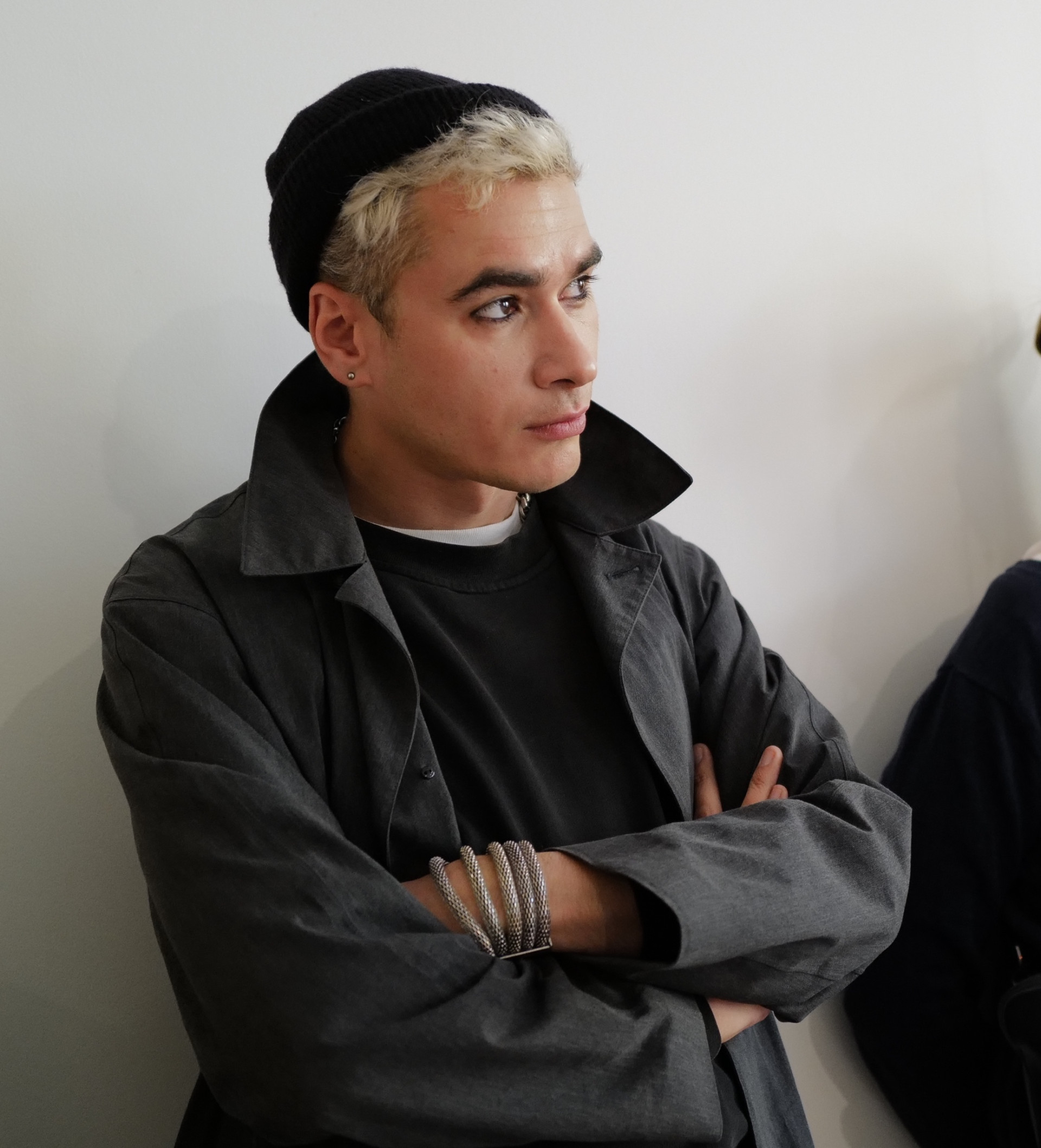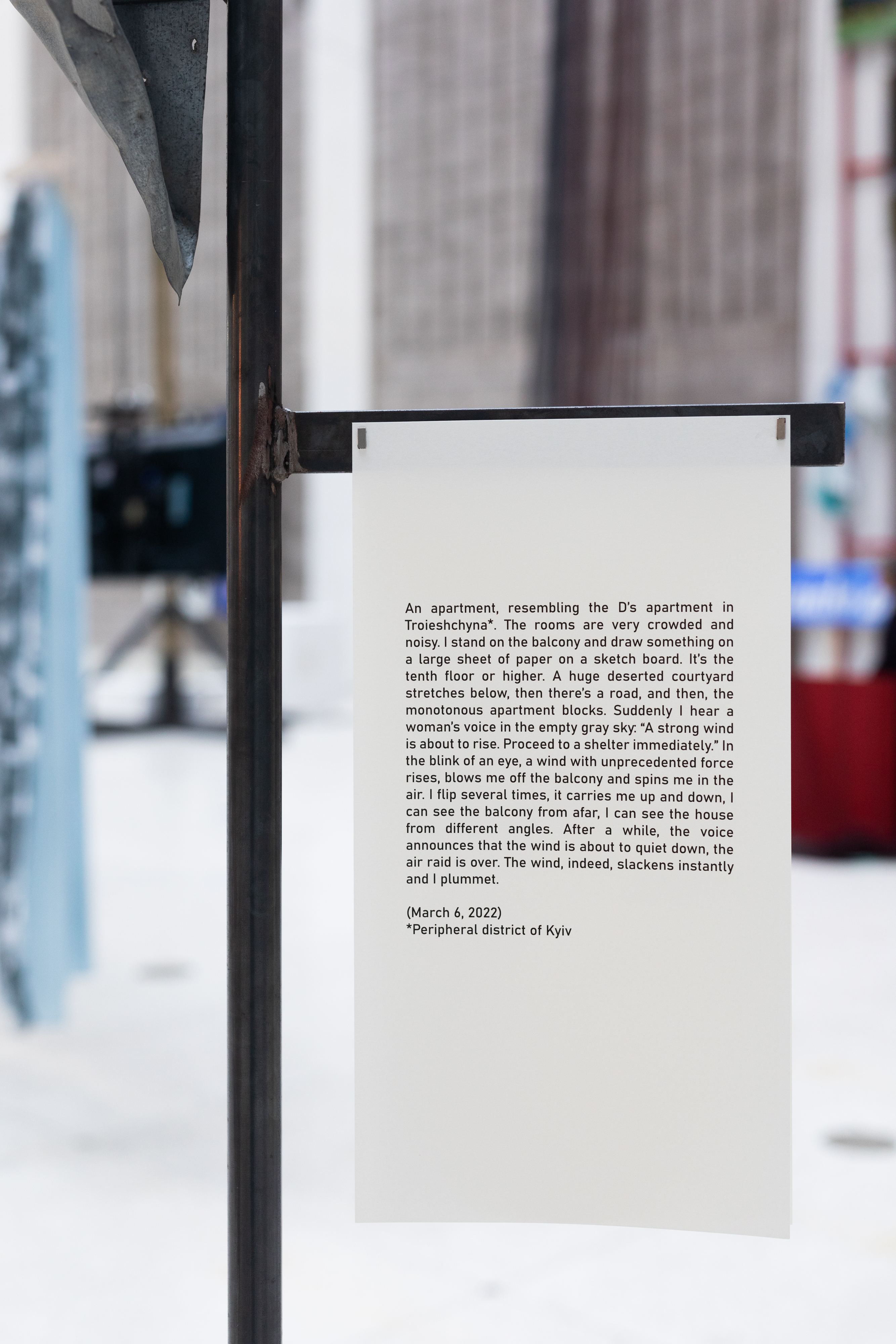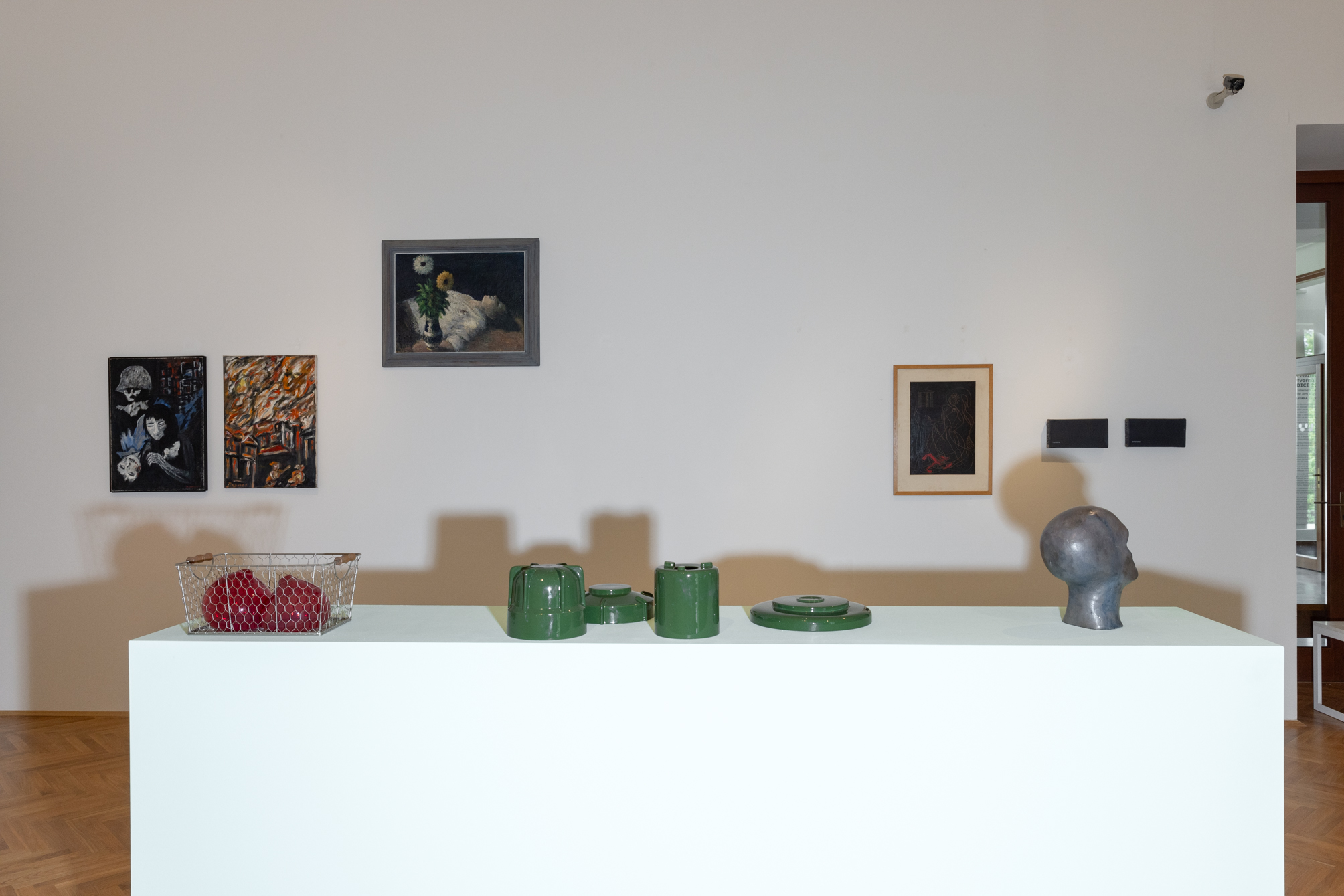Nikita Kadan
Work exhibited in the Trade Fair Palace:
Dream flags (Dolyna sculptures) / 2024 / installation / series of works (dimensions variable), metal, glass, reproduction of artworks: Lia Baraldi Cucconi, Two Handcuffed Nudes, 1967, ink on paper (30 × 21 cm); Jean Effel, Eva, undated (no later than 1968), ink on paper (46.5 × 61 cm); Guido Di Fidio, Martyr, 1966, ink on paper (50 × 35 cm); Renato Guttoso, Vietnam, 1965, ink and tempera on paper (50 × 24.5 cm); Hildo Krop, Old and New World, undated (no later than 1968), paper, linocut (23 × 17.5 cm); Hildo Krop, Poet Kvenvenaar, undated (no later than 1968), paper, linocut (22.5 × 17.5 cm); Anna Kindynnis, Hunger, 1963, charcoal on paper (46 × 39.5 cm) and Axl Leskoschek, linocut on paper from the series The Cain Cycle, 1964 (various sizes)—courtesy of the Lidice Art Collection, Lidice Memorial and the artist
* Commissioned by the Biennale Matter of Art Prague.
Dream flags (Dolyna sculptures), 2024, Biennale Matter of Art 2024, National Gallery Prague – Trade Fair Palace (c) Jonáš Verešpej
Nikita Kadan (lives in Kyiv, b. Kyiv (Ukraine), 1982) works with dark and traumatic histories. For him the historical violence is connected to what is happening with our world now. He was a constant observer of the war of Russia against Ukraine that has now lasted for 10 years. In 2014 Russia illegally occupied Crimea and parts of Donbas – the eastern part of Ukraine that is well known for mining. Eight years later, Russia launched a full scale invasion with an enormous amount of human death, and the destruction of cultural heritage and civic institutions. Nikita is interested in how history is remembered and represented in media and visual culture. How are monuments placed, how can monuments and images speak, and how can sculptures be evidence of crimes? In his recent works he uses the very same material that once was a fence, a roof or a wall but was damaged by Russian bombs. He creates sculptures that are also evidence of the Russian war. They show the tension between the catastrophe of war and the peaceful life of Europe, as well as the balance between weakness and strength, complicity and resistance. The artist also inserts records of his wartime dreams, blurring the line between the real and the subconscious. For the Matter of Art Biennale he presents a series of new sculptures. He asks whether a work of art can be proof of a war crime, or a record of suffering? The original panels were brought from Ukraine. It is a reminder of the war so close to Prague. His installation also hosts historical works from the Lidice Art Collection. In similar, yet historically distant contexts, these works were donated by artists as a gesture of solidarity to keep the memory of Nazi crimes in Lidice alive.
Work exhibited in the Lidice Gallery:
Dernier Poème [The Last Poem] / 2024 / curatorial intervention / artworks of the Lidice Art Collection: Michael Ayrton, Industrial Landscape, 1946, oil on plywood (41 × 61.5 cm); Arthur Degner, Lidice, undated (no later than 1968), oil on canvas (79 × 40 cm); Hans Grundig, Captive, 1936, dry needle on paper (24.7 × 32.5 cm); Hans Grundig, The Fugitive, 1936, dry needle on paper (25 × 32,7 cm); Hans Grundig, Imperialism, 1936, dry needle on paper (24.7 × 53.2 cm); Hans Grundig, SA Rules the Streets, 1936, dry needle on paper (24.7 × 32.5 cm); Hans Grundig, Resistance, 1936, dry needle on paper (34.5 × 38 cm); Georgies Kotsonis, Hero of the Acropolis, 1964, oil on cardboard, 47 × 33 cm; M. Marizza, Intolleranza, 1967, tempera on canvas (70 × 50 cm); Ján Mudroch, A Murdered Poet, undated (no later than 1968), oil on canvas, 34.5 × 69.5 cm, Tetiana Yablonska, A Couple, 1967, lithography on paper, (37.3 × 83 cm) – courtesy of the Lidice Art Collection, Lidice Memorial / and works by the artists: Kateryna Aliinyk, The bugs made a flute, 2024, acryl on canvas (50 × 70 cm); Yevgenia Belorusets, photography from the series Victories of the Defeated, 2014-2017, exhibition copy (60 × 40 cm); Yaroslav Futymsky, Untitled (Дети/Де ти), 2023, photography, digital print on paper (20 × 15 cm); Dana Kavelina, The animals have no destiny (in collaboration with Olha Marusyn), 2021, video (15 min 46 s); Dana Kavelina, Untitled (Animal drawings), 2024 / mixed materials on paper (20 × 30 cm); Nikita Kadan, Inhabitants of Colosseum, 2018, sound sculpture; Nikita Kadan, Люди (People), 2023, lithograph (70 × 87.5 cm); Yuri Leiderman, Ceausescu, 2020, oil on canvas (50 × 35 cm); Kateryna Lysovenko, Untitled, 2024, watercolor on paper (40 × 30 cm); Margaryta Polovynko, Untitled, 2022, artist's own blood on paper, 30 × 42 cm; Anton Saienko, Yaroslav Futymsky, Geography (of) Expulsion, 2022, oil on canvas (28 × 14 cm); Ilya Todurkin, Untitled (the Glossary), 2023, mixed materials on paper (61 × 86 cm) / courtesy of the artists
* Commissioned by the Biennale Matter of Art Prague.
Dernier Poème [The Last Poem], 2024, Biennale Matter of Art 2024, Lidice Gallery – Lidice Art Collection (c) Jonáš Verešpej, Tereza Havlínková
Nikita Kadan is an artist from Ukraine who makes works with the history of monuments, wars, destruction and collective trauma. He sometimes organizes exhibitions and works with art collections, for example the collection of Soviet art in Kmytiv, Ukraine. He puts together historical and contemporary works so they cast light on each other. For the Matter of Art Biennale he was invited to make an curatorial intervention at the Lidice Art Collection. Lidice is a place that remembers extreme forms of violence, but also international antifascist solidarity. The title refers to the last poem mistakenly attributed to Robert Desnos, a French surrealist poet and member of the resistance. He died a month after being released from the concentration camp Terezín close to Lidice. The curatorial intervention includes works of artists from the collection, as well as works by Ukrainian artists. These artists deal with their situation during the war of Russia against Ukraine. The artists mourn people who died, land that was poisoned, cultural heritage that was destroyed. Violence leaves many traces on our subconscious. We think about it, while grieving, working and even sleeping. Violence erodes boundaries between reality and the subconscious, daytime and nighttime, the monstrous and the breath-taking. The response to the Lidice massacre was solidarity – the call for roses to create a rose garden and calls for artworks were announced. But what are the ways to express solidarity with people who live through wars, ecological crises, dispossession – be it in Ukraine, Arzakh, and Palestine, among many other places. In putting together historical and contemporary works that provoke thinking about peace, resilience, and antifascism, we might find an answer. This exhibition is about being able to accept or reject the reality of war and refusal to see in war a new normality.

from the artist's archive
Trained in large-scale painting, Nikita Kadan’s artistic practice encompasses installation, graphics, painting, wall drawing, and urban postering, sometimes in collaboration with architects, human rights activists, and sociologists. His practice critically engages with the social, cultural, and political experiences of Ukrainian citizens and their current and past relationships to their former Soviet era. Kadan is a member of a Ukrainian artist collective called R.E.P. (Revolutionary Experimental Space) since 2004 and founding member of HUDRADA (Artistic Committee), a curatorial and activist collective, since 2008.













